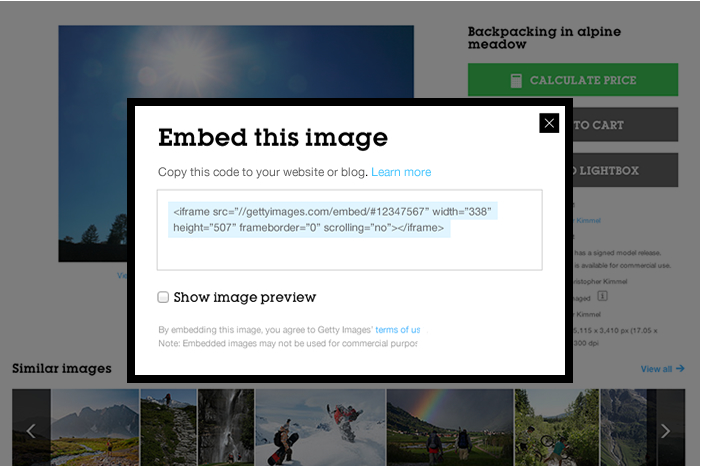Overnight, Getty Images has announced some big news for small users of images: a large selection of its image library will opened up for free use in non-commerical contexts. Photos will be made available using an embed code that credits the photographer and links back to Getty. Following from Getty's metadata deal with Pinterest in October last year, this is a clear indication that Getty has realised that the photographic landscape has changed and that in order to stay ahead of the game—where images are now common currency—it needs to evolve its models and practices.
As Jonathan Klein, Getty's co-founder and CEO put it: 'Whether via a blog, website or social media, everyone is a publisher and increasingly visually literate. Innovation and disruption are the foundation of Getty Images, and we are excited to open up our vast and growing image collection for easy, legal sharing in a new way that benefits our content contributors and partners, and advances our core mission to enable a more visually-rich world.'

Not all of its images will be embeddable, however, and photographers won't be given an opt-out. If you license your images via Getty, it's Getty which decides if they're to be free-to-use or not.
The two questions people are likely to be asking then are: how does this benefit Getty and how does it benefit photographers?
In many respects, it's the same answer for the two different questions. Images were already being used without a licence or without a fee being paid. Getty and photographers were fighting a losing battle, especially when images were used by small-time blogs and non-profits. By introducing a means to track use and ensure accreditation for free-to-use images, they can control their content better. It also opens up the possibility of monetisation options at a later date. The theory goes that it's better to give away something when you've little hope of making a profit from it, but keep tabs on it, than it is to try to keep content locked up but have it stolen and roaming free anyway.
When your pictures are being used legally for free, it makes it easier to ensure that they're paid for when they should be, too. Don't forget, this deal only covers images that are put to non-commercial use. Getty still want their fees from commercial enterprises.
However, I do anticipate a great many photographers being unhappy if not that their images can be licensed for free in non-commercial contexts, but that they don't have the opportunity to decide how their images can and cannot be used. It rather flies in the face of the notion that we don't work for exposure. I expect that from Getty's persepctive, it needed to be an all-or-nothing approach to ensure that the new venture got off the ground. Regardless, Getty will always demand its pound flesh, whether from image users or image makers. It might be a risk, but it's certainly a calculated one that Getty expects will reap dividends.
You can check out the embed feature here and ensure that you're making correct use of the free-to-use model by checking Getty's terms and conditions.





